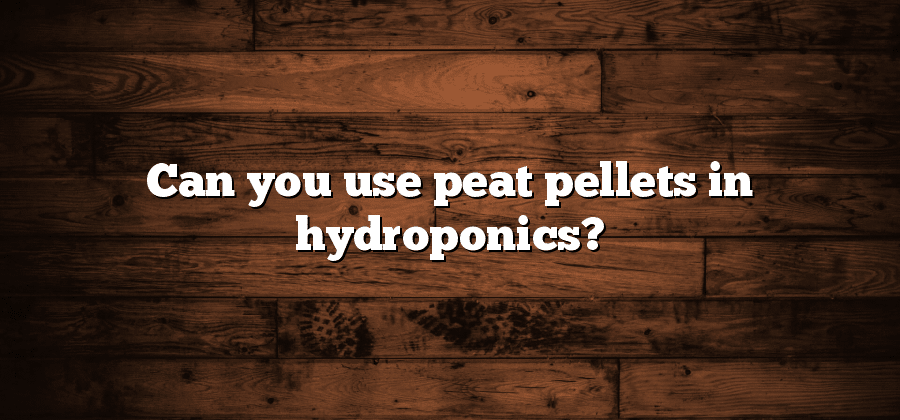Peat Pellets: An Overview
Peat pellets are widely used in hydroponic systems as a substrate for germinating and growing plants. These pellets are made from compressed peat moss, which is derived from decomposed plant material found in peat bogs. Peat moss is known for its ability to retain moisture and provide a stable medium for plant roots to grow.
One of the main advantages of using peat pellets in hydroponics is their convenience and ease of use. These compact pellets are lightweight and easy to handle, making them ideal for small-scale home gardening or commercial operations. Additionally, peat pellets provide excellent aeration for plant roots, allowing for efficient nutrient absorption and optimal plant growth. However, it is important to note that peat moss is a non-renewable resource, and its extraction can have negative environmental impacts. Therefore, it is crucial to consider sustainable alternatives and weigh the pros and cons of using peat pellets in hydroponic systems.
Understanding the Basics of Hydroponics
Hydroponics is a method of growing plants without soil. Instead, plants are grown in nutrient-rich water, allowing them to absorb the necessary nutrients directly through their roots. This innovative technique has gained popularity in recent years due to its numerous advantages.
One of the main benefits of hydroponics is that it requires less water compared to traditional soil-based gardening. This is because water can be recirculated in a closed-loop system, minimizing water wastage. Additionally, since the plants are not competing with other vegetation for nutrients in the soil, they are able to grow faster and produce higher yields. Moreover, the controlled environment of hydroponics allows for the precise control of temperature, humidity, and light, creating optimal growing conditions for plants. As a result, it is possible to grow crops year-round, regardless of external weather conditions.
The Role of Substrates in Hydroponics
In hydroponics, substrates play a crucial role in providing support and stability to the plants. A substrate is a medium through which water and nutrients are delivered to the plants’ root systems. It serves as a replacement for soil in traditional gardening, offering better control over nutrient distribution and water retention. Additionally, substrates help promote strong root development, which leads to healthier and more productive plants.
There are various types of substrates used in hydroponics, each with its own benefits and considerations. One popular choice is perlite, a lightweight and porous material that promotes good aeration and drainage. Another common substrate is coconut coir, which is made from the fibers of coconut husks. Coir retains moisture well and provides excellent drainage, making it suitable for a wide range of plant species. Other options include rockwool, expanded clay pellets, and vermiculite. The choice of substrate depends on factors such as the specific needs of the plants being cultivated, the water retention capacity required, and the overall system design.
Alternative Substrates for Hydroponic Systems
While traditional hydroponic systems often rely on substrates such as rockwool or perlite, there is a growing interest in exploring alternative options. One such alternative substrate gaining popularity is coconut coir. Made from the fibrous husk of coconuts, this natural and renewable resource offers several benefits. Coconut coir has excellent water retention properties while still providing adequate drainage, allowing for optimal root development. Additionally, it is pH-neutral and contains beneficial microorganisms that can enhance plant growth. However, it is worth noting that coconut coir may require buffering to adjust pH levels and initial preparation before use in hydroponic systems.
Another alternative substrate that has been gaining attention is expanded clay pellets. Made from high-density clay that is heated to high temperatures, these lightweight pellets offer excellent moisture retention and aeration properties. They do not break down over time, allowing for reuse in multiple growing cycles. Expanded clay pellets also provide a stable root environment for plants, reducing the risk of root rot and other common issues. However, it is important to note that expanded clay pellets can be costly and may require rinsing before use to remove any dust or debris. Despite these considerations, they remain a popular choice for hydroponic growers seeking an alternative substrate.
Examining the Pros and Cons of Peat Pellets
Peat pellets have gained popularity in the world of hydroponics due to their convenience and ease of use. These compact discs of compressed peat moss serve as an ideal substrate for germinating seeds and propagating plants. One of the major advantages of using peat pellets is their ability to retain moisture, providing a consistent environment for seedlings to develop. This ensures that the plants have a sufficient water supply, reducing the risk of dehydration.
However, despite their benefits, peat pellets do have some limitations. One of the main drawbacks is their limited nutrient-holding capacity. While they can retain moisture well, peat pellets do not provide an abundant supply of essential nutrients for growing plants. This means that after the initial germination phase, additional fertilizers or nutrient solutions may be required to sustain healthy plant growth. Additionally, it is important to note that peat moss is a non-renewable resource, and its harvesting can have detrimental effects on natural ecosystems. Therefore, those who prioritize sustainability might opt for alternative substrates that have less environmental impact.






